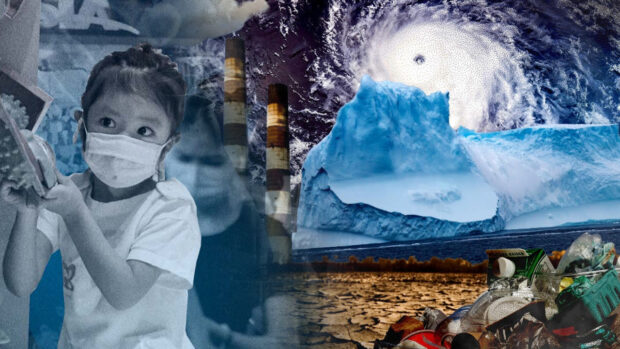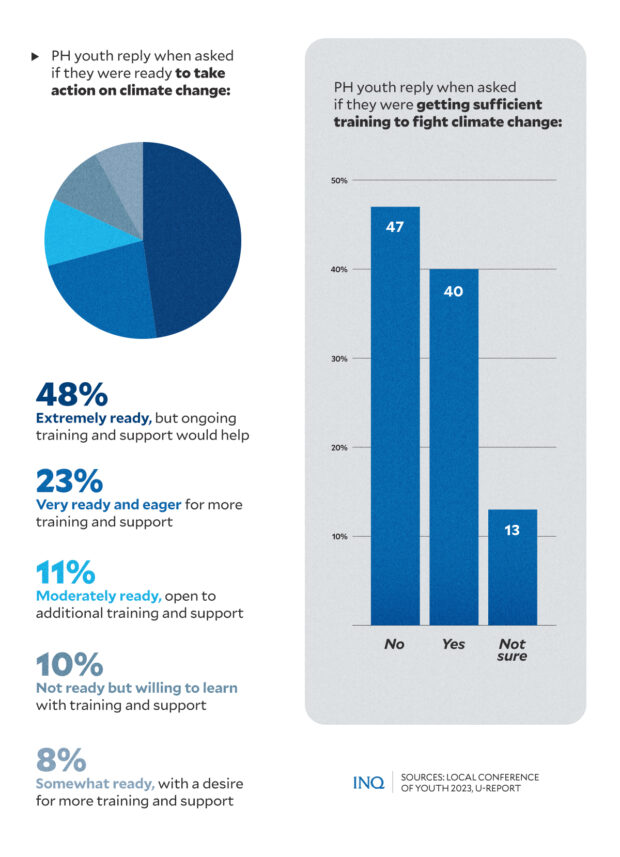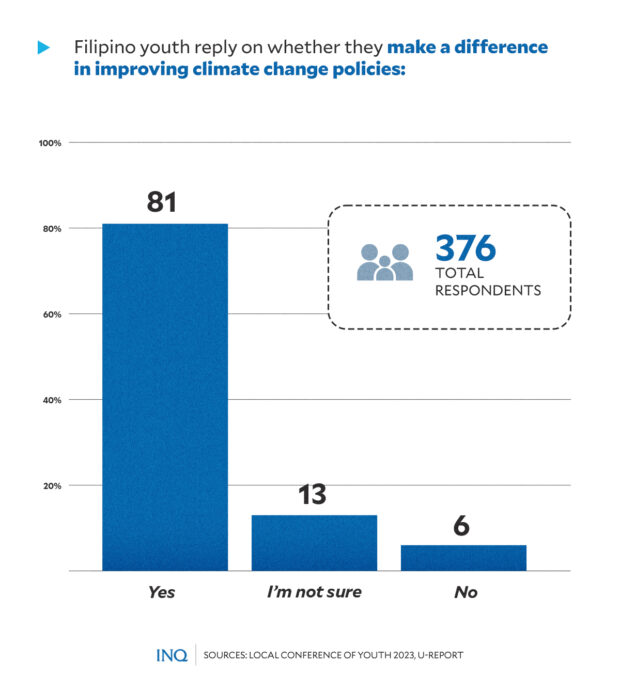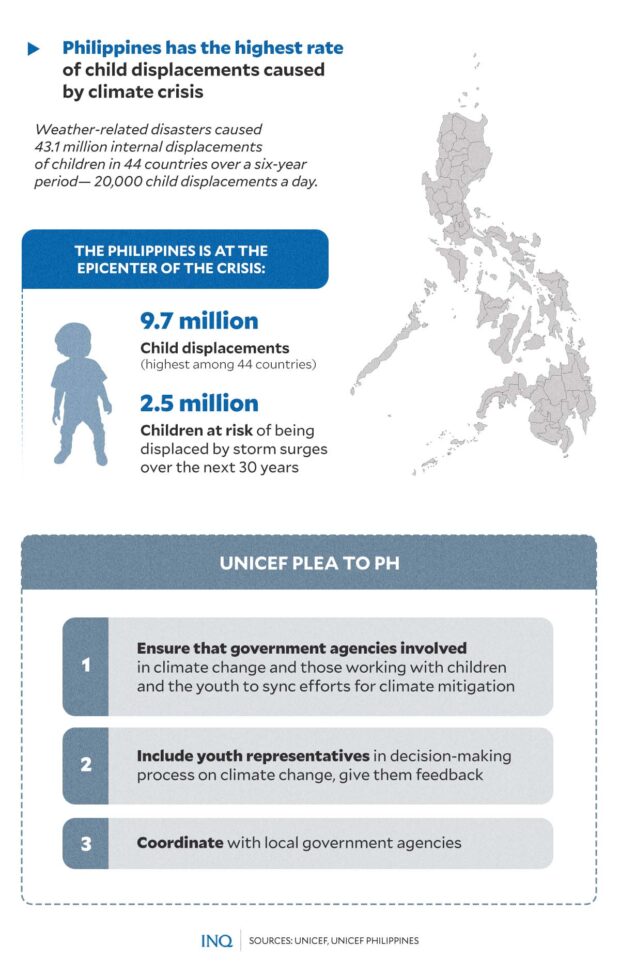PH youth, most vulnerable to climate change, most active in fighting crisis
MANILA, Philippines — While the world is nearing the point of no return on climate change, and with the Philippines being the global epicenter of the climate crisis, Filipino children are taking matters into their own hands through their own initiatives.
A recent global analysis by the United Nations Children’s Fund (Unicef) found that weather-related disasters caused 43.1 million internal displacements of children in 44 countries between 2016 and 2021.
The report said the Philippines is ground zero of the crisis “bearing the highest absolute number of child displacements at 9.7 million.” It said about 2.5 million children nationwide are at risk of being displaced by storm surges in the next 30 years.
“This risk is exacerbated by the fact that the country’s coastlines are highly susceptible to storm surges, and it can impact even densely populated cities such as Manila, Cebu, and Davao,” Unicef explained.
READ: Millions of children displaced due to extreme weather events
Despite having preparedness measures and innovations that could help when disasters strike, the report said the sheer number of children who could be potentially displaced by a single disaster event in the country is alarming.
A separate study in 2021 said children across 10 countries (Australia, Brazil, Finland, France, India, Nigeria, Philippines, Portugal, the UK, and the USA) experience climate and eco-anxiety or “distress relating to the climate and ecological crises.”
Over half of the 10,000 children surveyed for the study said they were “very” or “extremely worried.”
The Philippines recorded the highest number of surveyed children who felt “very worried” and “extremely worried” about climate change: 84 percent (49 extremely worried, 35 very worried).
READ: ‘Eco-anxiety’: PH children among most stressed by climate crisis
According to Unicef Philippines, children in the Philippines experience extreme levels of climate anxiety, yet they are also the most resilient and engaged in tackling the crisis.
“Every child must be assured about their future and protected from events that affect their mental well-being,” it added.
In this year’s celebration of World Children’s Day, the Quezon City government and Unicef Philippines recognized the voice, involvement, and leadership of children and youth in climate change efforts.
PH youth lead fight vs climate change
Results from surveys from the Local Conference of Youth 2023 (LCOY) and Unicef’s U-Report Philippines showed that young Filipinos are ready to do their part in addressing climate change and its impacts.
When asked about how ready they were to take action on climate change and disaster preparedness, 88 Filipino youths shared varied views and opinions:
- 48% said they are “extremely ready, but ongoing training and support would be helpful”
- 23% said they are “very ready and eager for more training and support”
- 11% said they are “moderately ready and open to additional training and support”
- 10% said they are “not ready, but willing to learn with training and support”
- 8% said they are “somewhat ready, with a desire for more training and support
A separate survey with 376 child respondents showed that 81 percent said they were aware that their actions could make a positive change in improving the climate policies in the country.
“Children in the Philippines are bearing the brunt of climate change. They need to be given more opportunity to meaningfully participate in the decisions and actions that affect them,” said Unicef Philippines representative Oyunsaikhan Dendevnorov.
“The voices, perspectives, and ideas of children and young people must be heard at the highest levels and taken seriously. Many children and youth are already doing their part,” she added.
Last Sunday (Nov. 19), an event called “Ngayon, Para Bukas! A Call for Collective Climate Action” was held in time for World Children’s Day and Climate Consciousness Week.
Among the youth-led programs highlighted by Unicef during the event included an organization protecting Irrawaddy dolphins in Western Visayas, an initiative teaching environmental and agricultural programs to public schools, a network of young environmentalist journalists, and an advocacy group that empowers communities living around the Pasig River.
More action needed
Unfortunately, the surveys also revealed that many Filipino children felt that they were not receiving the training and skills they needed to help them respond to climate change and its impacts.
Based on the survey results and dialogues with children and youths in the Philippines, U-Report Philippines, LCOY, and Unicef Philippines crafted the Filipino Youth Statement on Climate Action and Disaster Resilience 2023, which calls on the Philippine government to:
- Advocate for community-centered platforms for young people’s education and participation in climate action and disaster resilience.
- Develop effective, inclusive, and accessible storytelling for the climate and environment.
- Establish a mental health support network among children and youth working on climate action and disaster resilience.
- Build resilient communities that can effectively prevent, prepare for, and respond to disasters and climate change impacts.
- Establish inclusive, accessible, and safe spaces for all vulnerable sectors.
- Implement ridge-to-reef nature-based solutions involving children and youth.
- Empower children and youth to take action towards an inclusive, accessible, just, and regenerative agricultural and fisheries system.
- Empower children and youth to advanced accessible, just, and sustainable renewable energy and aquatic resources.
- Increase children and youth participation in strong implementation of effective waste management policies and programs.
- Create a safe and enabling environment for Indigenous Peoples and Local Communities (IPLCs) and environmental defenders through protection, meaningful engagements, and cultural strengthening.
- Support Micro Small and Medium Enterprises (MSMEs) that promote eco-conscious businesses built towards a circular economy.
READ: ‘The kids aren’t alright’: Global warming elevates risks to children
READ: Climate crisis exposes millions of children to dangers of frequent heatwave
READ: Climate change poses ‘lifelong’ child health risk
Climate crisis: Child rights crisis
The Philippines ranks first in terms of disaster risk according to the World Risk Index for 2022, as well as the first in the East Asia and Pacific region on the Child Climate Risk Index (CCRI).
“Extreme weather events are increasing in frequency, and slower onset climate impacts, such as rising sea levels and increasing temperatures are affecting the health, nutrition, and education of children in the country,” Unicef Philippines said.
“Poor children, children with disabilities, children who belong to indigenous groups, children in situations of armed conflict, and girls, are especially vulnerable,” it added.
Climate change, Unicef said, is a child’s rights crisis. Environmental harm and climate change pose a significant threat to children’s rights globally.
“The climate crisis is a child rights crisis. Governments must protect the rights of every child, especially boys and girls living in countries that have contributed least to this problem but are enduring the most dangerous floods, storms, and heat,” said Dendevnorov.



